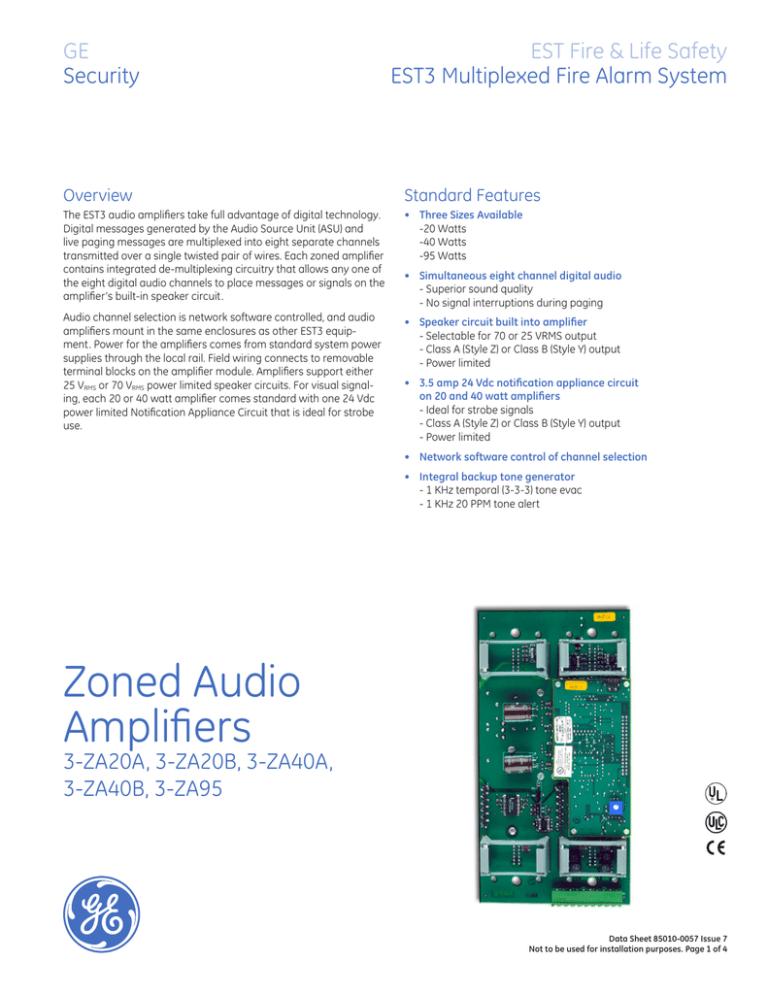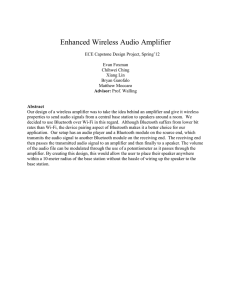
GE
Security
EST Fire & Life Safety
EST3 Multiplexed Fire Alarm System
Overview
Standard Features
The EST3 audio amplifiers take full advantage of digital technology.
Digital messages generated by the Audio Source Unit (ASU) and
live paging messages are multiplexed into eight separate channels
transmitted over a single twisted pair of wires. Each zoned amplifier
contains integrated de-multiplexing circuitry that allows any one of
the eight digital audio channels to place messages or signals on the
amplifier’s built-in speaker circuit.
• Three Sizes Available
-20 Watts
-40 Watts
-95 Watts
Audio channel selection is network software controlled, and audio
amplifiers mount in the same enclosures as other EST3 equipment. Power for the amplifiers comes from standard system power
supplies through the local rail. Field wiring connects to removable
terminal blocks on the amplifier module. Amplifiers support either
25 VRMS or 70 VRMS power limited speaker circuits. For visual signaling, each 20 or 40 watt amplifier comes standard with one 24 Vdc
power limited Notification Appliance Circuit that is ideal for strobe
use.
• Speaker circuit built into amplifier
- Selectable for 70 or 25 VRMS output
- Class A (Style Z) or Class B (Style Y) output
- Power limited
• Simultaneous eight channel digital audio
- Superior sound quality
- No signal interruptions during paging
• 3.5 amp 24 Vdc notification appliance circuit
on 20 and 40 watt amplifiers
- Ideal for strobe signals
- Class A (Style Z) or Class B (Style Y) output
- Power limited
• Network software control of channel selection
• Integral backup tone generator
- 1 KHz temporal (3-3-3) tone evac
- 1 KHz 20 PPM tone alert
Zoned Audio
Amplifiers
3-ZA20A, 3-ZA20B, 3-ZA40A,
3-ZA40B, 3-ZA95
Data Sheet 85010-0057 Issue 7
Not to be used for installation purposes. Page of 4
Application
EST3 zoned amplifier configurations offer improved system survivability and performance. Configuration provides improved survivability in the event of wiring faults that result in a loss of signaling.
In the example shown in the diagram, a fault on the system using a
central backed-up amplifier disables multiple signal/page circuits,
and the standby amplifier is not able to bypass the fault. With EST3,
the same fault removes the Audio Source Unit riser.
Central
Amplifier
Zoned
Amplifiers
Short on Riser
disables all
circuits
Short on Riser
disables signal
source
Standby Amplifiers
are local in nodes
Standby Evacuation
Tone at each Amplifier
For example, with an alarm on Floor Eight, the following automatic
message instructions could be given concurrently. Note: A Page
could also be sent to any other location in the building – without
interrupting any of the messages below.
FLOOR 9 HEARS: “A fire alarm has been reported on the floor below.
Please evacuate using the stairwell.”
FLOOR 8 HEARS: “A fire alarm has been reported on this floor.
Please evacuate using the stairwell.”
OTHER FLOORS HEAR: “An emergency has been reported on floor 8.
Please remain in the building and await further instructions.”
ELEVATOR: “A fire alarm has been reported in the building. The
elevator is being returned to the ground floor for emergency use.
Please evacuate the building.”
STAIRWELLS: “Please remain calm and walk down the stairs to
evacuate the building in a safe manner.”
Engineering Specification
Because all EST3 zoned amplifiers have an integrated backup
1000 Hz temporal tone generator, the locally-generated alarm
tones notify occupants of a hazard – even with the primary riser
out of commission. The backup tone also operates if the ASU or the
audio distribution system fails. To further enhance system survivability, a single standby amplifier can backup any zoned amplifier
in the same cabinet.
Zoned amplifiers can be housed in remote cabinets close to the
speakers. This minimizes the voltage drop between the amplifier
and the load, and permits the use of a smaller wire size than is possible with centrally-located amplification systems.
EST3 easily outperforms banked audio systems with its ability to
simultaneously deliver up to eight different signals. When using
centrally-banked amplifiers, paging and alert channels typically
share a common amplifier. Consequently, when paging, the alert
signal goes silent in all alerted areas when a Page is issued. At the
end of the Page, the alert signal resumes in the alert area, which
could cause confusion because occupants did not receive the page
message and do not know why the Page stopped and restarted.
The audio system shall provide simultaneous page, alert, evacuation, elevator, stairwell and auxiliary signaling. Systems that
cause signaling devices to go silent while performing any signaling
functions will not be accepted. The Audio System shall provide 8
separate audio channels for simultaneous paging and signaling
purposes. The audio system zoned amplifiers must be able to operate 25 VRMS or 70 VRMS speakers. The amplifier output must be power
limited, and wired in a <Class A (Style Z)> <Class B (Style Y)> configuration. The amplifiers shall provide an integral backup 1000 KHz
temporal tone generator which shall operate in the event signal
primary audio signals are lost and the amplifier is instructed to
broadcast alarm information. It shall be possible to backup multiple
zoned amplifiers with a common backup amplifier.
Typical Wiring
+
VISUAL NOTIFICATION APPLIANCE CIRCUIT
Not available on 3-ZA95
+
+
+
+
UL/ULC Listed 15KW EOL
For Class B circuits only
+
Class A circuits only
COMMON ENCLOSURE
Field wiring identical
to amplifier #1
15KW EOL
With EST3, simultaneous page, alert, and evacuation signal capability is engineered into the system. With eight channels to choose
from, dedicated messages can be delivered to stairwells, elevator
cabs, etc. while alert, evacuation, and page instructions are simultaneously being sent to the rest of the building. The eight audio
channels allow messages to be automatically routed, and provide
specific instructions based on the alarm’s location.
1
2
3
4
5
6
7
8
9
10
1
To TB1 on Audio Amplifier
2
3
4
5
6
7
8
9
10
To TB1 on Audio Amplifier
TB1
7
6
5
4
3
5
6
7
8
Field wiring identical
to amplifier #1
9
10
1
2
3
4
5
6
7
8
9
10
To TB1 on Audio Amplifier
AUDIO
AMPLIFIER
MODULE
(Zone #2)
(ZONE #1)
2
4
To TB1 on Audio Amplifier
AUDIO
AMPLIFIER
MODULE
(Zone #3)
TB2
To TB2 on Audio Amplifier
8
3
TB1
TB2
9
2
AUDIO
AMPLIFIER
MODULE
AUDIO
AMPLIFIER
MODULE
(Backup)
10
1
1
10
9
8
7
6
5
4
3
2
To TB2 on Audio Amplifier
1
10
9
8
7
6
5
4
3
2
To TB2 on Audio Amplifier
1
10
9
Field wiring identical
to amplifier #1
8
7
6
5
4
3
2
1
Field wiring
identical to
amplifier #1
Connection for Shield when used
Dual
Bank
Central
Distributed
Zoned
Amplifiers
Legend
+
Speaker
UL/ULC Listed 15KW EOL
For Class B circuits only
+
Visual Notification
Appliance
Class A circuits only
EOL Resistor
AUDIO NOTIFICATION APPLIANCE CIRCUIT
Page
Alert
Evacuation
Page
Alert
Evacuation
Auxiliary
Stairwell
Elevator
Environmental
Emergency
Data Sheet 85010-0057 Issue 7
Not to be used for installation purposes. Page of 4
Specifications
3-ZA20A
Agency Listing
Environmental
Frequency Response
Output Voltage
THD (distortion)
Wire Size
Internal Tone Generator
SIGA-CC1/2 Support
Standby Current
Alarm Current
Pwr. Ltd. Audio Output
Wiring Configuration
EOL Resistor
Pwr. Ltd. 24 Vdc NAC
Wiring Configuration
1120mA
Class A or B
(Style Z or Y)
15K Ohms in Class B
Class A or B
(Style Z or Y)
Line Resistance, Max.*
EOL Resistor Line
Capacitance, Max
Space Requirements
50 Ohms, Max.
N/A
0.33µF
3-ZA20B
3-ZA40A
3-ZA40B
UL, ULC, CE
0°C - 49°C (32°F - 120°F) 93% RH, Non-condensing
400Hz to 4KHz @ +/- 3dB
25 VRMS or 70 VRMS
< 7%
18 to 12 AWG (1.0 to 2.5 mm²)
1KHz Temporal (3-3-3) Tone (evacuation); 20 PPM (alert)
10 Units, Maximum
62mA for 20 and 40 watt amps;
64mA for the 3-ZA95 watt amp
1120mA
2480mA
2480mA
Class A or B
Class B (Style Y)
Class B (Style Y)
(Style Z or Y)
15K Ohms
15K Ohms
15K Ohms in Class B
Class B
Class A or B
Class B
(Style Y)
(Style Z or Y)
(Style Y)
50 Ohms, Max.
50 Ohms, Max.
15 K Ohms
N/A
0.33µF
0.33µF
1 LRM Space
Maximum Speaker Circuit Distance at 0.5 dB loss*
70 VRMS Output
3-ZA20A
3-ZA20B
#12 AWG
4,536 ft (1,382 m)
(3.2 Ohm/1000 ft pair)
#14 AWG
2,792 ft (850 m)
(5.2 Ohm/1000 ft pair)
#16 AWG
1,815 ft (553 m)
(8.0 Ohm/1000 ft pair)
#18 AWG
1,117 ft (340 m)
(13 Ohm/1000 ft pair)
25 VRMS Output
3-ZA20A
3-ZA20B
#12 AWG
579 ft (176 m)
(3.2 Ohm/1000 ft pair)
#14 AWG
356 ft (108 m)
(5.2 Ohm/1000 ft pair)
#16 AWG
231 ft (70 m)
(8.0 Ohm/1000 ft pair)
#18 AWG
142 ft (43 m)
(13 Ohm/1000 ft pair)
* Refer to product manual for wire run calculations.
50 Ohms, Max.
15K Ohms
0.33µF
3-ZA95
5540mA
Class A or B
(Style Z or Y)
15K Ohms in Class B
N/A
2 LRM Spaces
3-ZA40A
3-ZA40B
3-ZA95
2,268 ft (691 m)
955 ft (290 m)
1,396 ft (425 m)
588 ft (179 m)
907 ft (276 m)
382 ft (116 m)
558 ft (170 m)
235 ft (71 m)
3-ZA40A
3-ZA40B
3-ZA95
289 ft (88 m)
122 ft (37 m)
178 ft (54 m)
75 ft (22 m)
116 ft (35 m)
49 ft (14 m)
71 ft (21 m)
Not supported
by 18 AWG
Ordering Information
Catalog Number
3-ZA20A
3-ZA20B
3-ZA40A
3-ZA40B
3-ZA95
Description
20 Watt Zoned Amplifier w/Class A/B (Style Z/Y) Audio & Class A/B (Style Z/Y) 24 VDC outputs
20 Watt Zoned Amplifier w/Class B (Style Y) Audio & Class B (Style Y) 24 VDC outputs
40 Watt Zoned Amplifier w/Class A/B (Style Z/Y) Audio & Class A/B (Style Z/Y) 24 VDC outputs
40 Watt Zoned Amplifier w/Class B (Style Y) Audio & Class B (Style Y) 24 VDC outputs
95 Watt Zoned Amplifier w/Class A/B (Style Z/Y) Audio output
Ship Wt., lb. (kg)
1.55 (0.7)
1.55 (0.7)
1.55 (0.7)
1.55 (0.7)
3.0 (1.5)
Data Sheet 85010-0057 Issue 7
Not to be used for installation purposes. Page of 4
GE
Security
U.S.
T 888-378-2329
F 866-503-3996
Canada
T 519 376 2430
F 519 376 7258
Asia
T 852 2907 8108
F 852 2142 5063
Australia
T 61 3 9259 4700
F 61 3 9259 4799
Europe
T 32 2 725 11 20
F 32 2 721 86 13
Latin America
T 305 593 4301
F 305 593 4300
www.gesecurity.com/est
© 2008 General Electric Company
All Rights Reserved
Data Sheet 85010-0057 Issue 7
Not to be used for installation purposes. Page of 4


